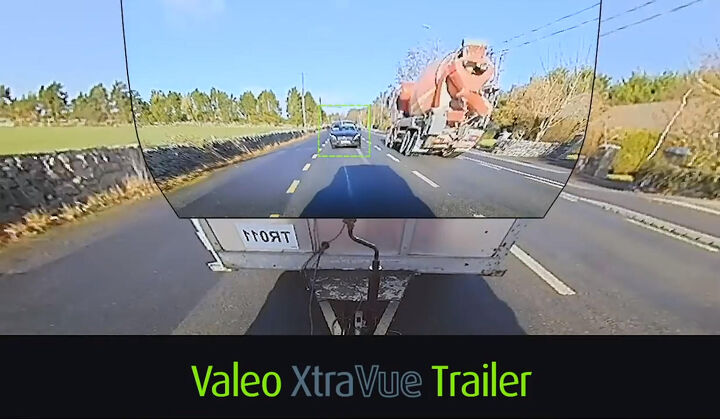Valeo Previews 'Invisible' Trailer System at CES 2019

With so many bewildering and downright fantastical automotive concepts premiering at the Consumer Electronics Show this time of year, it’s easy to feel downtrodden by the industry’s mobility shenanigans. Thankfully, CES still plays host to some genuinely interesting tech that might actually make your life a little easier.
For French automotive supplier Valeo, that meant showcasing a system that utilizes cameras and some very careful framing to effectively see through a towed object. Called the XtraVue Trailer system, the technology works in a similar fashion as the nanotechnology invisibility blanket under development by the U.S. military — just much simpler.
Rather than use an elaborate projective fabric that records and mimics whatever’s behind it, à la Predator, XtraVue uses traditional cameras fixed to the back of the vehicle and accompanying trailer and projects a composite image onto a large screen that’s easily visible to the driver.
By keying out areas obscured by the trailer, Valeo can effectively render it “invisible” to the person behind the wheel, creating downright sublime rearward visibility. Still, similar systems already exist on the market. Companies like Rear View Safety Inc. already offer dozens of solutions for those wanting a better sense of their surroundings whilst towing. What makes Valeo’s setup a little different is that its system creates a seemingly complete image when properly set up, even providing a basic outline of the trailer using a screen-within-a-screen effect.
XtraVue is supposed to work directly with a vehicle’s standard backup camera, using a secondary camera at the back of the trailer to fill in the gaps keyed out by the imaging software. We imagine the supplier wants to work directly with automakers to get this into factory vehicles, rather than take the aftermarket approach. However, the current demonstration does not have the system integrated into the car’s infotainment system.
Distortion will likely become a problem the larger and longer a trailer gets, at which point you might want to consider a multi-camera setup. But XtraVue looks impressive when used on a smaller rig. Based on footage provided but the supplier, we doubt spacial issues would only crop up in extremely tight quarters, but that’s a pretty inconsequential gripe considering the system will absolutely make towing safer.
Valeo also brought a couple of autonomous concepts to CES. One, a vehicle dubbed “Drive4U,” uses the company’s ultrasound, cameras, radars, and LiDAR systems in conjunction with artificial intelligence. While self-driving remains Drive4U’s ultimate goal, the supplier is also working on ways to control it from a distance. One of those is a remote control that syncs with the car’s functions, but an interesting alternative exists in the company’s Voyage XR, which creates a sort of virtual driving experience.
With Voyage XR, users can pop on a VR headset and manually control the car. It’s a fascinating concept, offering a potential glimpse into our very sedentary future.
Call us old fashioned if you must, but we’re slightly more fond of the invisible trailer idea.
[Images: Valeo]

A staunch consumer advocate tracking industry trends and regulation. Before joining TTAC, Matt spent a decade working for marketing and research firms based in NYC. Clients included several of the world’s largest automakers, global tire brands, and aftermarket part suppliers. Dissatisfied with the corporate world and resentful of having to wear suits everyday, he pivoted to writing about cars. Since then, that man has become an ardent supporter of the right-to-repair movement, been interviewed on the auto industry by national radio broadcasts, driven more rental cars than anyone ever should, participated in amateur rallying events, and received the requisite minimum training as sanctioned by the SCCA. Handy with a wrench, Matt grew up surrounded by Detroit auto workers and managed to get a pizza delivery job before he was legally eligible. He later found himself driving box trucks through Manhattan, guaranteeing future sympathy for actual truckers. He continues to conduct research pertaining to the automotive sector as an independent contractor and has since moved back to his native Michigan, closer to where the cars are born. A contrarian, Matt claims to prefer understeer — stating that front and all-wheel drive vehicles cater best to his driving style.
More by Matt Posky
Latest Car Reviews
Read moreLatest Product Reviews
Read moreRecent Comments
- Zerofoo The green arguments for EVs here are interesting...lithium, cobalt and nickel mines are some of the most polluting things on this planet - even more so when they are operated in 3rd world countries.
- JMII Let me know when this a real vehicle, with 3 pedals... and comes in yellow like my '89 Prelude Si. Given Honda's track record over the last two decades I am not getting my hopes up.
- JMII I did them on my C7 because somehow GM managed to build LED markers that fail after only 6 years. These are brighter then OEM despite the smoke tint look.I got them here: https://www.corvettepartsandaccessories.com/products/c7-corvette-oracle-concept-sidemarker-set?variant=1401801736202
- 28-Cars-Later Why RHO? Were Gamma and Epsilon already taken?
- 28-Cars-Later "The VF 8 has struggled to break ground in the increasingly crowded EV market, as spotty reviews have highlighted deficiencies with its tech, ride quality, and driver assistance features. That said, the price isn’t terrible by current EV standards, starting at $47,200 with leases at $429 monthly." In a not so surprising turn of events, VinFast US has already gone bankrupt.




































Comments
Join the conversation
Erm I think Land Rover already launched this system 2 years ago: https://www.google.co.uk/amp/s/www.carmagazine.co.uk/amp/car-news/tech/does-it-work-land-rover-transparent-trailer-car-february-2016/ Shocking that no one else had copied it so far, especially Jeep as their owner led tow things too!
That is a great system for drivers pulling a trailer. But I never pull a trailer, though I find myself quite often in heavy tractor-trailer traffic on highways. What I would consider a great system is one with a screen on the rear of the trailer that shows me what is going on *in front of* the tractor.